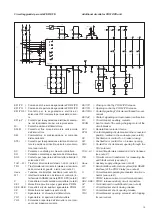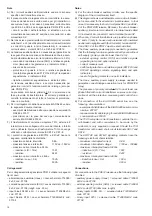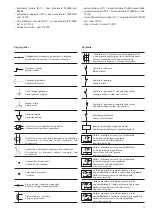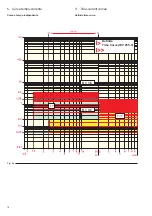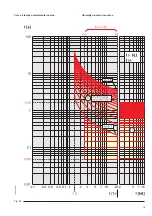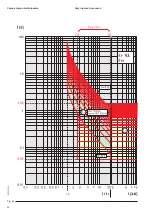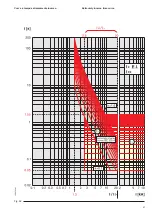
6
Dove:
I
= corrente di sovraccarico
I>
= corrente di soglia regolata
t
= tempo di intervento
α − β
= costanti che definiscono il tipo di caratteristica
K
= fattore di moltiplicazione del tempo di intervento
3.1.1. Scelta del valore di soglia (I>)
L'impostazione di I> viene effettuata agendo sui 6 dip switch
indicati in fig. 1 - rif. 1.
La somma dei valori selezionati rappresenta la frazione di In
corrispondente a I>.
Sono disponibili 32 valori di soglia, così definiti: 0,2 ... 1 x In con
passo 0,025 x In (non è possibile la predisposizione a 0,6 x In).
La protezione può essere esclusa posizionando il primo dip
switch sulla posizione OFF.
Nella seguente tabella si evidenziano le possibili
predisposizioni.
Where:
I
= overload current
I>
= set threshold current
t
= trip time
α − β
= constants which define the type of characteristic
K
= multiplication factor of the trip time
3.1.1. Selection of the threshold value (I>)
Setting the I> is carried out by acting on the 6 dip-switches
shown in fig. 1 - ref. 1.
The sum of the values selected represents the fraction of In
corresponding to I>.
32 threshold values are available, defined as follows: 0.2 ... 1
x In with steps of 0.025 x In (presetting to 0.6 x In is not possible).
The protection can be excluded by positioning the first dip-
switch on OFF.
The table below shows the possible settings.
3. Funzioni di protezione
Il PR512/P (50-51) realizza due funzioni di protezione (indi-
pendenti ed escludibili) contro sovraccarico e cortocircuito.
3.1. Protezione contro sovraccarico (51)
La funzione di protezione elabora il vero valore efficace (RMS)
per valori di corrente tra 0,2 e 2 x In. Per valori superiori la
protezione lavora sul valore di picco.
Sono disponibili 4 diverse famiglie di curve di protezione:
– Tempo indipendente regolabile (DT = Definite Time/tempo
indipendente)
– Tempo inverso (NI = Normally Inverse/tempo inverso)
– Tempo molto inverso (VI = Very Inverse/tempo molto inverso)
– Tempo estremamente inverso (EI = Extremely Inverse/tem-
po estremamente inverso).
Il valore di soglia di questa protezione viene indicato con I>,
mentre il relativo tempo d'intervento viene indicato con t>.
L'inizio della temporizzazione è segnalata dall'accensione
del led ALARM (fig. 1 - rif. 7) mentre l'avvenuta apertura
dell'interruttore è segnalata frontalmente dalla bandierina
magnetica I> I>> (fig. 1 - rif. 6) ruotata nella posizione di color
giallo.
Per ripristinare questa segnalazione è necessario premere il
pulsante FLAG RESET (fig. 1 - rif. 20) sul fronte dell'unità
garantendo una delle seguenti condizioni:
a) tensione ausiliaria 24 V cc presente (display acceso);
b) corrente circolante primaria maggiore di 0,2 x In (display
acceso con indicazione della corrente circolante);
c) applicazione del dispositivo TT2 al connettore TEST (fig.
1 - rif. 30) posto sul fronte dell'unità (accessorio a richiesta).
Per le protezioni a tempo indipendente, il tempo di intervento
delL'unità è dato dalla relazione:
t = K x
β
Per le protezioni a tempo inverso, in accordo con le Norme IEC
255-4, il tempo d'intervento è dato dalla relazione:
β
t> = K x
[I/I>]
a
- 1
3. Protection functions
The PR512/P (50-51) carries out two protection functions
(which are independent and can be excluded) against over-
load and short-circuit.
3.1. Protection against overload (51)
The protection function calculates the true effective value
(RMS) for current values between 0.2 and 2 x In. For higher
values, the protection works on the peak value.
There are 4 different families of protection curves available:
– Definite adjustable time (DT = Definite Time)
– Inverse time (NI = Normally Inverse time)
– Very inverse time (VI = Very Inverse time)
– Extremely inverse time (EI = Extremely Inverse time)
The threshold value of this protection is indicated by 1>,
whereas the relative trip time is indicated by t>.
The start of timing is signalled by the ALARM LED lighting up
(fig. 1 - ref. 7), whereas circuit-breaker opening is signalled on
the front by the magnetic flag I> I>> (fig. 1 - ref. 6) in the yellow
position.
To reset this signal, the FLAG RESET button must be pressed
(fig. 1 - ref. 20) on the front of the unit, thereby guaranteeing one
of the following conditions:
a) 24 V d.c. auxiliary voltage present (display lit);
b) primary circulating current higher than 0.2 x In (display lit
with indication of the current circulating);
c) application of the TT2 device to the TEST connector (fig. 1
- ref. 30) on the front of the unit (optional accessory).
For the definite time protections, the trip time of the unit is given
by the following relation:
t = K x
β
For inverse time protections, in compliance with IEC 255-4
Standards, the trip time is given by the relation:
β
t> = K x
[I/I>]
a
- 1
Содержание PR512
Страница 2: ......
Страница 21: ...19 Curva a tempo normalmente inverso Fig 9b Normally inverse time curve...
Страница 22: ...20 Fig 9c Curva a tempo molto inverso Very inverse time curve...
Страница 23: ...21 Fig 9d Curva a tempo estremamente inverso Extremely inverse time curve...
Страница 43: ......

















